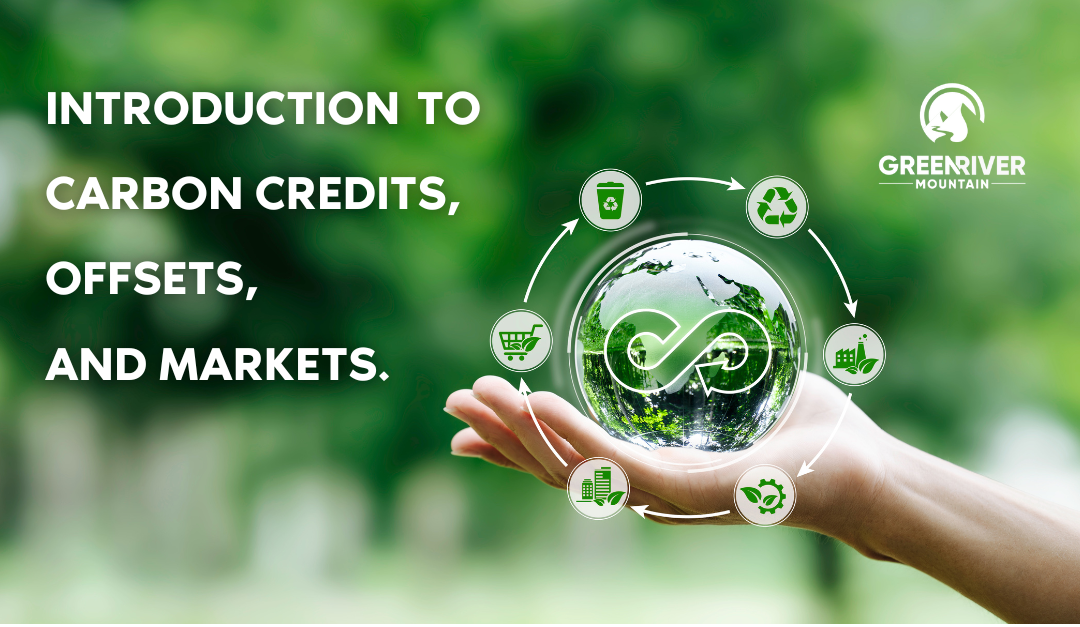An Introduction to Carbon Credits, Offsets, and Markets
The Kyoto Protocol of 1997 and the Paris Agreement of 2015 were monumental international accords that set global CO2 emissions goals. With widespread ratification, these agreements have led to national emissions targets and supportive regulations, increasing the pressure on businesses to reduce their carbon footprint. Carbon markets have emerged as a critical tool in this effort, turning CO2 emissions into a commodity with a price.
What Are Carbon Credits?
Carbon credits are a way of valuing or pricing how much a company is reducing its greenhouse gas emissions. Companies that directly reduce their emissions, including CO2, can earn credits for doing so. These credits can be valuable to other companies that aren’t able to meet their greenhouse gas reduction targets, creating a market where carbon credits are bought and sold. Each carbon credit represents one metric ton of CO2 emissions and is traded as a transferable certificate or permit until it is used by a company and effectively retired.
For investors interested in ESG-centered strategies (i.e., companies that follow proactive environmental, social, and governance policies), learning how to invest in carbon credits can be compelling.
Understanding Cap and Trade
An important dynamic to understand when investing in carbon credits is the worldwide cap-and-trade market. Certain governments have implemented programs that limit the amount of greenhouse gases that companies can emit each year. Over time, the cap can be reduced, forcing companies to invest in green technologies and reduce their emissions. Any emissions above the cap must be covered with the purchase of carbon credits, otherwise, the company must pay a fine.
Companies that reduce their emissions can sell excess carbon credits to other companies, making a profit. As governments lower emissions caps, demand for carbon credits increases, driving up their price. Not every country has a cap-and-trade policy, but they have gained traction in the European Union, certain states in the U.S., the U.K., China, and New Zealand.
How Have Carbon Credits Become a Big Market?
A significant and growing portion of global greenhouse gas emissions is now covered by carbon pricing initiatives and voluntary market purchases. The compliance carbon credit market, created by governments, and the voluntary carbon market are both critical components of this system. In the voluntary market, companies choose to purchase carbon offsets to cancel out their emissions through projects like tree planting and renewable energy production.
Investing in Carbon Credits
Carbon markets in the U.S. are not as robust as in other countries, but there are several ways investors can get started:
- Carbon Credit ETFs: Exchange-traded funds (ETFs) that track the performance of carbon markets.
- Carbon Credit Futures: Futures contracts linked to carbon credits, suitable for experienced investors.
- Individual Companies: Investing in stocks of companies that generate or actively trade carbon credits.
Other ways include investing in private companies focused on carbon credits or using new exchanges that offer retail investors exposure to curated portfolios of carbon credits.
Pros and Cons of Investing in Carbon Credits
Pros:
- Profitability: Potential for high returns as the market grows.
- Environmental and Social Benefits: Incentivizes companies to reduce emissions.
- Accessibility: ETFs offer an easy entry point.
- Low Supply and Increasing Demand: Limited supply and increasing corporate demand.
- Diversification: Adds variety to investment portfolios.
Cons:
- Potential Risks: Volatility and lack of extensive performance data.
- Narrow Exposure: Limited to certain regions and markets.
- Limited Environmental Impact: Companies can buy credits instead of reducing emissions.
- Quality Variations: Not all carbon credits are equal; ensure purchases are through reputable sources.
The Carbon Marketplace
The carbon marketplace consists of regulated markets governed by cap-and-trade regulations and voluntary markets where businesses and individuals purchase credits to offset emissions. Both markets play essential roles in reducing global carbon emissions.
Corporate Social Responsibility (CSR)
Consumers are increasingly aware of the importance of reducing carbon emissions, leading companies to participate in carbon offset projects. This participation signals a commitment to combating climate change and can enhance a company’s reputation.
Conclusion
Carbon credits and offsets represent powerful tools for reducing global emissions and fostering sustainability. At Green River Mountain (GRM), we believe in the potential of these mechanisms to create a greener future while offering unique investment opportunities. By participating in carbon markets, investors can contribute to global climate action and benefit from the growing demand for sustainable practices.
Green River Mountain (GRM) is an alternative investment sponsor dedicated to preserving wealth while fostering a more sustainable future. The information provided is of the opinion of Green River Mountain and for educational purposes only and is not intended as investment advice. GRM does not offer advisory services. Green River Mountain provides access to diverse investment opportunities not available in REITs or funds, and charitable donations that align with sustainable practices. Green River Mountain offers alternative investment opportunities with diversification benefits to institutional, family offices, and accredited private investors through registered broker dealers and wealth management advisory firms.
